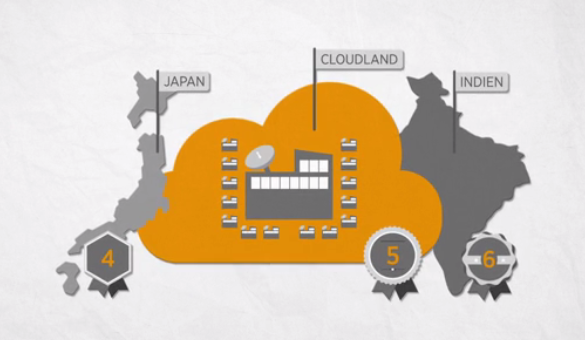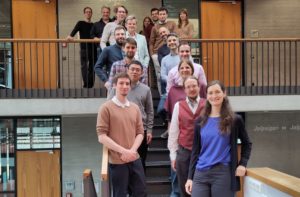Smart Heat: Heat from the Cloud
February 29, 2016
 Cloud&Heat offers its customers two products which would have seemed totally unrelated a couple of years ago: cloud computing and heat for space or water heating. To extract usable heat, Cloud&Heat has developed a special water cooling system for server cabinets to achieve temperatures of 55 °C. Usually, 90 % of the electricity consumed by servers is waste heat. As a consequence, much additional power is required to dissipate the heat. “Our Green Cloud doubles down on saving energy by covering both the cooling and heating demand of residential buildings,” explains Jens Struckmeier, one of the three founders of Cloud&Heat. So far, the IT specialists have installed about 650 servers supplying heat to 25 building projects. Cloud&Heat estimates that the growing number of cloud servers worldwide consume as much energy as an entire country – more than India but less than Japan (see chart on the left.
Cloud&Heat offers its customers two products which would have seemed totally unrelated a couple of years ago: cloud computing and heat for space or water heating. To extract usable heat, Cloud&Heat has developed a special water cooling system for server cabinets to achieve temperatures of 55 °C. Usually, 90 % of the electricity consumed by servers is waste heat. As a consequence, much additional power is required to dissipate the heat. “Our Green Cloud doubles down on saving energy by covering both the cooling and heating demand of residential buildings,” explains Jens Struckmeier, one of the three founders of Cloud&Heat. So far, the IT specialists have installed about 650 servers supplying heat to 25 building projects. Cloud&Heat estimates that the growing number of cloud servers worldwide consume as much energy as an entire country – more than India but less than Japan (see chart on the left.Source: Cloud&Heat
Since summer 2014, 20 server cabinets in the underground car park of the building have supplied heat to the newly constructed blocks of flats of building society WG Aufbau Dresden in Dresden, Germany. The computer waste heat meets 90 % of the domestic water requirements and 30 % of the heat required by the underfloor heating system of the 56 housing units. The heat is fed from the computers to the buffer tank of the heating system. District heating operator Stadtwerke Dresden, DREWAG, buys the heat from Cloud&Heat and sells it to the tenants. The remaining peak load is covered by DREWAG´s district heating network.
Server cabinet produces up to 20 kW of heat
Every server of the new generation presented at the CeBIT trade fair in Hanover, Germany, in March last year produces up to 275 W of heat and contains two processors with up to 24 cores each. Overall, one server cabinet with a width of 0.8 metres, a depth of 1.5 metres and a height of 2 metres can generate up to 20 kW of heat, meaning that the servers are similar to conventional heating regarding the space needed for them. They also do not require special climatic conditions or security precautions. The cabinet is thermally insulated, protected against fire as well as unauthorised access.
Obviously, not all the server waste heat can be used for space and water heating in summer, which is why a free cooling system is used to keep server temperatures in check. Either air is dispersed throughout the server room or the heated water is transported outside the building. As the most recent generation of systems heats the water to 55 °C and the next one will increase the temperature even to 65 °C, there is always enough of a temperature difference to dispose of the heat in a standard environment – no active cooling required.
The process makes the Cloud&Heat data centres very energy efficient. The so-called power usage effectiveness (PUE), which describes the ratio of the total electricity consumed in the data centre (including cooling) to the power actually delivered to computing equipment shows a world-record value of 1.01 for the Dresden project, according to Cloud&Heat. The average PUE for German data centres is 1.6; worldwide it is 1.8.
Smart heating: Servers get priority computing tasks if building heat demand is high
Besides the special cooling design, Cloud&Heat has developed a tool for the smart distribution of the cloud’s computing power. The control units at the server locations inform the central control system about the current heat demand of the buildings. Whenever possible, the servers in buildings with heat demand will get priority computing tasks, so they produce more heat. Cloud&Heat patented this smart control unit in Germany and has filed an international application too. Naturally, the monitoring system is not only good for smart heating but also essential for optimising the cloud computing services.
High cloud heat demand
So far, Cloud&Heat has been offering three models to heat customers. The first one has Cloud&Heat own and operate the server. What the customer buys from Cloud&Heat is the infrastructure required to incorporate waste heat into the heating system and get rid of left-over heat in summer. It also means that the customer has to guarantee Cloud&Heat access to the server. With this model, Cloud&Heat delivers a certain amount of heat free of charge to the customer. So far, it seems to have become the model favoured by most customers. The second option is a conventional energy service contract, producing heat at prices about 10 % lower than district heating. But as it turns out, the interest in the supposed by-product heat is bigger than in cloud computing itself. “Even without much marketing effort, we received 1,000 requests from people interested in using our computers for heating,” Struckmeier says. This has led Cloud&Heat to promote a third model, in which the customer purchases both the server and the heating system from the company. Cloud&Heat operates and monitors the server as part of a service contract. In case more computing power is needed during peak times, the customer can book additional cloud capacity.
The Cloud&Heat approach has been combined with PV plants in several cases, but not with solar thermal. “Some customers have shown interest in thermal cooling with adsorption chillers in summer,” Struckmeier says. “Over the long term, combinations with fuel cells might also be used to provide power to the servers.”
Besides the federal state of Saxony, whose energy agency granted some incentives, heating by computer waste heat is not a typical case for direct incentive programmes. But the primary energy factor of the generated heat is 0.0, which increases the overall energy efficiency of the building dramatically. This either saves money to meet energy performance criteria set by the government or, if the building exceeds those, leads to higher incentives by the German KfW banking group.
Additionally, Cloud&Heat, says that their approach is economically feasible on its own: In a small data centre with ten server cabinets producing 20 kW of thermal power each, the solution saves up to 665 tonnes of CO2 per year or EUR 220,000 in cooling energy and generates heat saving 350 tonnes of CO2 per year (compared to gas heating) worth EUR 150,000. Compared with a data centre employing conventional cooling, costs are only 10 % higher.
Until now, the system has only been sold in Germany, but Cloud&Heat has already had plans to sell it in other countries.
More information:
Cloud&Heat: http://www.cloudandheat.com


